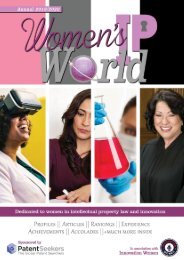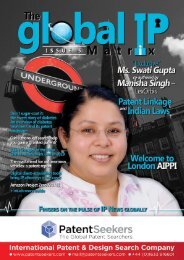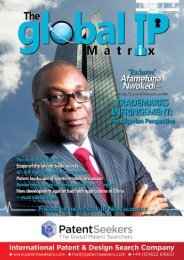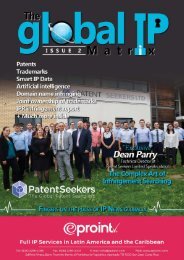Global IP Matrix - Issue 7
Dear readers, We sincerely hope that you are all in good health and keeping in good spirits during these undeniably uncertain times. We have all had to adapt to working out of our comfort zones, which I am sure has been very challenging at times for you all as it has been for us. However, we continue our quest to look to the future and deliver exclusive content to you, direct from thought leaders working at ground level in the IP industry from all over the world. Issue 7 of The Global IP Matrix magazine is packed with informative and exciting articles to keep you up to date and educated in what has been developing in the global IP industry during the past few months and into the future. We hope you enjoy reading our publication. We want to thank all our contributors for sharing their knowledge, opinions, and expertise in this new edition of the Global IP Matrix magazine. From all of us at The Global IP Matrix & Northon's Media, PR & Marketing Ltd
Dear readers,
We sincerely hope that you are all in good health and keeping in good spirits during these undeniably uncertain times. We have all had to adapt to working out of our comfort zones, which I am sure has been very challenging at times for you all as it has been for us.
However, we continue our quest to look to the future and deliver exclusive content to you, direct from thought leaders working at ground level in the IP industry from all over the world.
Issue 7 of The Global IP Matrix magazine is packed with informative and exciting articles to keep you up to date and educated in what has been developing in the global IP industry during the past few months and into the future. We hope you enjoy reading our publication.
We want to thank all our contributors for sharing their knowledge, opinions, and expertise in this new edition of the Global IP Matrix magazine.
From all of us at The Global IP Matrix & Northon's Media, PR & Marketing Ltd
Create successful ePaper yourself
Turn your PDF publications into a flip-book with our unique Google optimized e-Paper software.
Patent Searching 101:
How to Efficiently Conduct A Search
Geraint James is an IP Manager
at Patent Seekers Limited and has
developed an expertise in patent
search and analysis across multiple
disciplines. He is a key member of the
company’s patent search teams. He is
involved in thousands of searches for
international patent attorneys both
in private practice, in-house, and for
major blue-chip companies. Geraint
has also helped develop PatWorld, a
global patent search database, which
has been designed to include all the
tools required for a professional
patent search, with an intuitive user
interface and tools for use by searchers
of any level of expertise.
Introduction
Patent searching can be a valuable tool
to ensure a productive and efficient route
through the lifecycle of a product. At Patent
Seekers, we conduct a variety of professional
patent and non-patent searches, ranging
from pre-filing (patentability), through to
State of Art, Invalidity (patent busting),
and Freedom to Operate (FTO). Some
IP professionals are often put-off from
conducting their own patent searching
as they believe they lack the expertise to
conduct an efficient search, or simply do not
have the time to perform a search.
Written by Geraint James, IP Manager at Patent Seekers Limited
www.patentseekers.com
With over 100 years of combined searching
experience, we have fine-tuned our searching
practices to be as productive as possible. This
article will share with you the tips, tricks, and
tools that we use to run efficient patent searches
using the PatWorld patent search database,
along with the type of searches that you can run
that produce the most valuable results in the
shortest time possible.
How to begin a search
There is no one-size-fits-all approach when it
comes to patent searching, and each search type
will require a slightly different search strategy.
Broadly, these can be broken down into three
categories:
I. Prior art (for Patentability, pre-filling,
etc.) –worldwide territories, with no date
limitations.
II. Invalidity – apply a suitable date
limitation (e.g., search for documents
with a priority date before the priority or
application date of the patent in suit)
III. FTO – limit to the territories of interest
and consider using a date limit for patents in
force (i.e., filed in the last 20 years).
Setting appropriate limitations for your
search will reduce the number of results
to review and improve efficiency.
Once you have set an appropriate
limitation, the next step is to generate
a list of keywords that can be used to
describe the invention. Spending a few
minutes exploring possible synonyms and
variations in spellings (e.g., aluminium and
aluminum) will improve efficiency when
searching as you can refer to this list to generate
your search strings. When gathering keywords,
it may help to write a concise search scope to help
focus on the key aspects of the invention.
Staying Organised
Keeping an organised record of your search and
results will significantly improve the efficiency
of your searching. Patent searching is often an
iterative process, where your search strategy
will evolve as you search and analyse results,
therefore knowing what results you have already
reviewed will help prevent reviewing the same
result twice. PatWorld includes several tools to
organise your searching, integral to the projectbased
interface, which saves search histories and
folders into separate work files. Search histories
will keep a log of your search and can be used to
remove the results from one search from another.
Additionally, keeping an organised record of
your search and results will allow you to revisit
a search.
How to get the most
out of the search tools
1. Semantic searching
The semantic (smart) search tool is a fantastic
way of producing patent results with little to
no time and effort. When running a semantic
search, consider how well the text describes the
invention to be searched as semantic algorithms
will extract what it deems are key concepts
from the text and searches these within patents.
Semantic searches can be performed on search
scopes, draft claims, invention disclosures, or
text from other relevant patent documents such
as abstracts or claims. We would recommend
running a semantic search as the first step in a
patent search, as this can often generate results
with minimal time spent and form the basis for
additional searching.
3. Classification Searching
Classification searching effectively negates the need to search for synonyms of keywords. For this
reason, when searching within a classification using keywords, it is important not to search for any
keywords used in the class descriptor (e.g., avoid searching for “waking stick” in a classification for
such). Additionally, classifications can often be combined to search for overlapping subject matters; for
example, searching for a classification containing walking sticks AND a classification for pedometers
will return results that are walking sticks with pedometer functions. Use the classification tool to
search for relevant classifications or look at the classifications listed on similar patents.
4. Assignee/Inventor Searching
Name searching can be used to find patents that are likely associated with a company or a product
on sale. If searching for the main proprietor name (or main inventors) does not produce the results
needed, consider investigating possible parent companies or subsidiaries as IP can often be held in
these names. If your search is associated with a product and said product has a registered trademark,
check the trademark holder’s name as this could give the names of the patent holders.
5. Analysis tools
Analysis tools such as charts, graphs, and maps can be used to gain valuable insight into competitors and
patent landscapes. Using the analysis tools in PatWorld, we can analyse a plurality of metrics, including
filing trends of competitors, global distribution of a technology and analyse agents/representatives
who work with competitors, or who are active in an area. To analyse a competitor, simply search the
company name in the Assignee field and click “create charts” on the results generated. Alternatively, to
gain a snapshot analysis of a technology, create a broad dataset (using keywords and/or classifications)
that would feature a good representation of the technology to be searched.
1. Checks on relevant results
Once you have found relevant results, one of the quickest and most efficient ways of uncovering other
relevant results is to check the citations of the relevant patents. This requires very little time and effort
and can be an iterative process where you may check the citations of new results found in this way.
Additionally, checking for other patents owned by the assignee and/or inventor can often return other
similar results.
Analysing Results
When viewing and analysing results, PatWorld features several tools that you can use to identify
relevant results quickly. When viewing and analysing results, we recommend using the highlighting
tool to highlight key terms and increase the review speed. When selecting keywords to highlight,
consider focussing on the main terms that will distinguish results (i.e., key inventive features).
Additionally, the keywords-in-context tool will only show you where specific keywords appear in the
context of the patent result.
PatWorld also features a star rating system, which
can be used to rate a result from one to five, and a
note feature that adds a note to the result.
Reporting Results
The Report Generator tool in PatWorld can
generate a professional standard report in a few
seconds. After rating and annotating the results
you want to include in the report, click in the
“generate report” tool and select the content of
your report. Using these tools will negate the
need for manually copy-and-pasting information
from a web browser into a word processor that
can be laborious.
Conclusion
Using these tools and techniques
can significantly improve
the efficiency of your patent
searching. Investing a small
amount of time before searching
to gather keywords and ascertain
limitations for your search will
improve the speed and accuracy
of your search. Keeping your
searching focussed on the key
aspects and using tools such as
semantic searching and citation
checks where available will help
you prioritise your search time
better. Advancing your search
by including classifications can
provide greater coverage and
identify results that would not
be picked up from keyword
searching only.
Analysis tools can provide
valuable data on competitors and
patent trends. These charts and
graphs can provide an excellent
supplement to a search report.
2. Keyword (Text) Searching
When conducting a quick, investigatory search,
limit your search terms to the key synonyms,
and focus on the main ways of describing your
invention. Use proximity operators to search for
Finally, use the report tool to
keywords in proximity to each other. PatWorld
generate a professional standard
proximity operators are n#, where # represents the
distance between two keywords—for example,
report document as efficiently as
searching (“walking stick” n5 pedometer), which
possible.
would search for “walking stick” within five
words of “pedometer”. After reviewing these
results, you may uncover additional synonyms or
ways of describing the invention that you could
use to expand your searching.
10 www.gipmatrix.com www.gipmatrix.com
11












